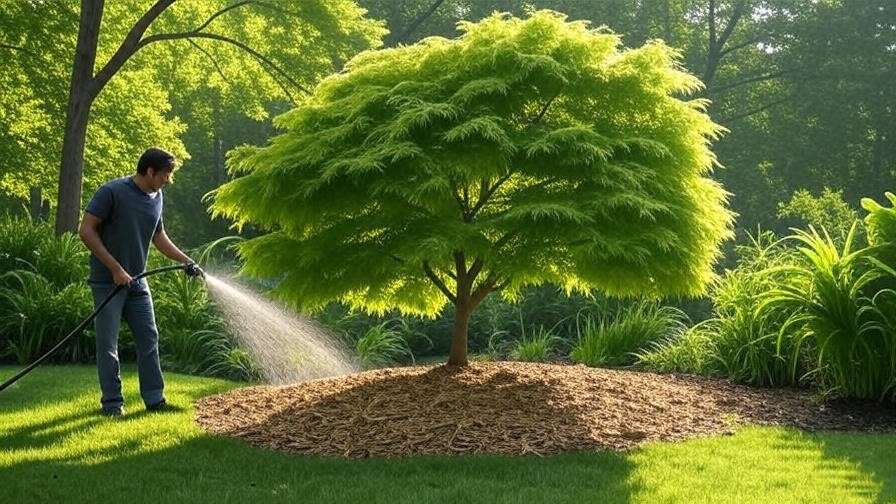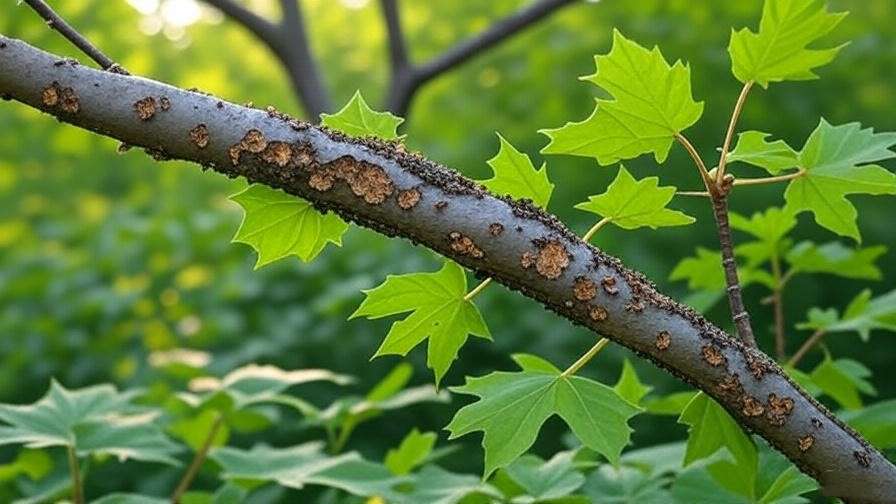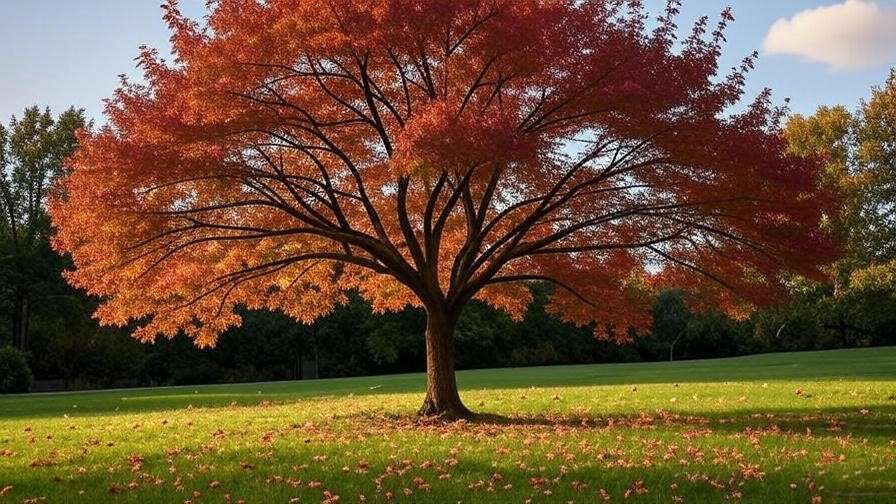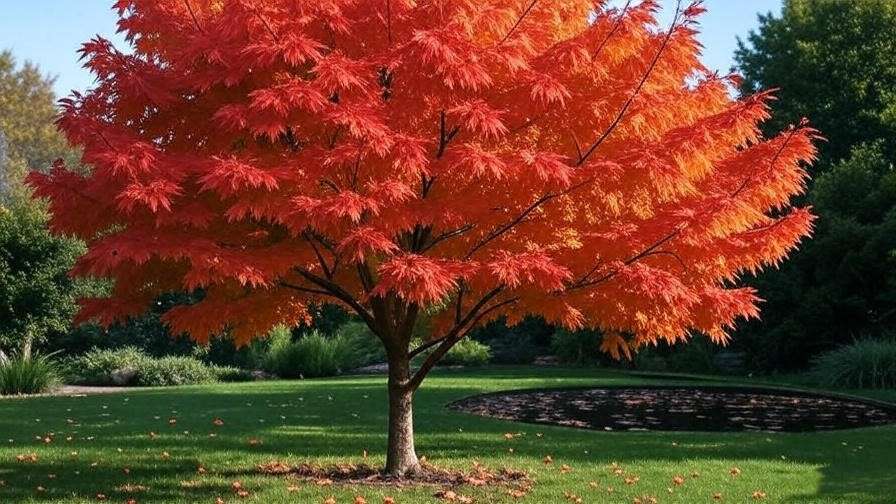Imagine a tree so breathtaking that its shimmering, wavy-grained wood and vibrant fall foliage stop you in your tracks. That’s the curly maple tree, a standout variety of the sugar maple (Acer saccharum) that’s capturing the hearts of gardeners and landscapers alike. Whether you’re dreaming of a showstopping centerpiece for your yard or aiming to nurture a healthy, long-lived tree, mastering curly maple tree care is your key to success. This guide dives deep into everything you need to know—from planting and watering to pest control and long-term maintenance—ensuring your curly maple thrives for generations. Backed by arboricultural expertise and trusted horticultural insights, this comprehensive resource will empower both novice and seasoned gardeners to cultivate a curly maple that’s as healthy as it is stunning. 🌿
What Is a Curly Maple Tree? 🌟
Overview of Acer saccharum (Sugar Maple)
The curly maple tree, a captivating variant of the sugar maple, is renowned for its distinctive curly or wavy grain, which creates a mesmerizing, almost three-dimensional effect in its wood. Scientifically known as Acer saccharum, this deciduous tree is native to North America and thrives in temperate climates. Beyond its ornamental appeal, the curly maple’s wood is prized in woodworking for crafting furniture, musical instruments like guitars, and even decorative veneers. Its unique grain pattern, combined with its ecological and aesthetic value, makes it a favorite for homeowners and landscapers. 🌲

Unique Characteristics
Curly maples grow to a mature height of 50-80 feet, with a spread of 30-50 feet, making them ideal for spacious yards or parks. Their leaves, typically five-lobed, turn brilliant shades of red, orange, and yellow in fall, creating a spectacular seasonal display. The tree’s bark is smooth and gray in youth, becoming furrowed with age, adding texture to landscapes. With proper care, curly maples can live over 200 years, offering long-term beauty and shade. Their hardiness and adaptability make them a resilient choice for various environments. 🍁
Why Choose a Curly Maple?
Why invest time and effort in growing a curly maple? Beyond its visual appeal, this tree provides ample shade, supports local wildlife like birds and pollinators, and contributes to a healthier ecosystem by sequestering carbon. For gardeners, it’s a chance to cultivate a legacy tree that enhances property value and curb appeal. However, curly maples require specific care to reach their full potential, addressing common pain points like soil preparation and pest management. This guide will equip you with the tools to overcome these challenges and enjoy the rewards of a thriving curly maple. 🌳
Ideal Growing Conditions for Curly Maple Trees 🌞
Climate and Hardiness Zones
Curly maples flourish in USDA hardiness zones 3-8, encompassing much of the United States and parts of Canada. They prefer cool to moderate climates with average temperatures between 60-75°F during the growing season. While they tolerate cold winters, extreme heat or prolonged drought can stress the tree, making regional climate considerations critical. For example, in zone 3, protect young trees from harsh winter winds, while in zone 8, ensure adequate moisture during hot summers. Checking your local hardiness zone ensures you’re set up for success. ❄️☀️
Soil Requirements
Soil is the foundation of a healthy curly maple. These trees thrive in well-drained, loamy soil with a pH of 5.5-7.0 (slightly acidic to neutral). Test your soil using a home kit or consult a local extension service to confirm pH and nutrient levels. If your soil is too clay-heavy, amend it with organic matter like compost or aged manure to improve drainage. Sandy soils may need additional organic material to retain moisture. Avoid compacted or waterlogged sites, as these can stunt root growth and lead to decline. 🌱
Sunlight and Location
Curly maples need full sun to partial shade, ideally receiving 4-6 hours of direct sunlight daily. Choose a planting site with ample space to accommodate the tree’s mature size, avoiding areas near power lines or buildings. Ensure the location has good air circulation to reduce disease risk, but protect young trees from strong winds. A south- or east-facing slope is ideal for maximizing sunlight while minimizing water pooling. Proper site selection sets the stage for vibrant foliage and robust growth. 🌞
Planting Your Curly Maple Tree 🌱
When to Plant
Timing is critical for planting curly maples. Early spring (after the last frost) or early fall (6-8 weeks before the first frost) are ideal, allowing roots to establish before extreme weather. In colder regions (zones 3-4), spring planting is preferable to avoid winter stress. In warmer zones (7-8), fall planting leverages cooler temperatures and increased rainfall. Check your local frost dates to pinpoint the best window for your area. 🗓️
Step-by-Step Planting Guide
- Select a Healthy Sapling: Choose a nursery-grown curly maple with a straight trunk, healthy leaves, and no signs of pests or disease. A 4-6 foot sapling is ideal for home planting.
- Prepare the Hole: Dig a hole twice as wide and as deep as the root ball. Loosen the soil to encourage root penetration.
- Position the Tree: Place the tree in the hole, ensuring the root collar (where the trunk meets the roots) sits level with the ground. Avoid planting too deep, as this can suffocate roots.
- Backfill and Tamp: Fill the hole with native soil mixed with compost, gently tamping to remove air pockets.
- Water Thoroughly: Soak the soil to settle it around the roots, adding more soil if needed.
- Stake if Necessary: Use stakes for support in windy areas, but remove them after one year to promote strong trunk development.
Expert Tip: Inspect the root ball for circling roots and gently tease them apart to encourage outward growth. 🌳

Watering After Planting
For the first year, water your curly maple deeply once a week, providing 1-2 inches of water (about 5-10 gallons for a young tree). Adjust based on rainfall—use a rain gauge to monitor. Overwatering can lead to root rot, signaled by yellowing leaves or soggy soil, while underwatering may cause wilting or leaf drop. Apply water slowly at the base, allowing it to penetrate the root zone. Mulching with 2-3 inches of organic material (e.g., wood chips) helps retain moisture and regulate soil temperature. 💧
Essential Care Tips for a Thriving Curly Maple 🌿
Watering Needs
Once established (after 1-2 years), curly maples need less frequent watering but still require consistent moisture. Provide 1-2 inches of water weekly during dry periods, using a soaker hose or drip irrigation for efficiency. In hot climates, monitor for drought stress (e.g., curling leaves) and increase watering slightly. Avoid overhead watering to prevent fungal diseases. A 3-4 inch layer of mulch around the base (keeping it 2 inches from the trunk) reduces evaporation and keeps roots cool. 🌧️

Fertilizing for Optimal Growth
Fertilize curly maples in early spring with a balanced, slow-release fertilizer (e.g., 10-10-10 or 12-12-12) to support growth. Apply 1-2 pounds of fertilizer per 100 square feet of root zone, spreading it evenly and watering thoroughly afterward. Avoid fertilizing late in the season, as this can stimulate new growth vulnerable to frost. Test soil every 2-3 years to check nutrient levels—over-fertilizing can burn roots, causing leaf scorch or stunted growth. Organic options like composted manure are excellent for long-term soil health. 🌱
Pruning and Shaping
Prune curly maples in late winter or early spring, before sap flow begins, to maintain structure and remove dead or damaged branches. Use clean, sharp tools to make angled cuts just outside the branch collar. Focus on:
- Removing crossing or rubbing branches.
- Thinning the canopy for better air circulation.
- Shaping young trees to encourage a strong central leader.
Avoid heavy pruning, as it can stress the tree. For large branches, consult a certified arborist to ensure safety and proper technique. 🪚
Mulching and Weed Control
Apply a 2-4 inch layer of organic mulch (e.g., bark, wood chips) around the tree’s base, extending to the drip line but avoiding contact with the trunk. Mulch conserves moisture, regulates soil temperature, and suppresses weeds. Remove grass and weeds within a 3-foot radius of the trunk, as they compete for nutrients and water. Hand-pull weeds or use a natural herbicide for persistent growth, ensuring no chemicals contact the tree’s roots. Refresh mulch annually to maintain its benefits. 🌾
Protecting Your Curly Maple from Pests and Diseases 🐞
Common Pests
Curly maple trees, like other maples, can attract pests that threaten their health if not managed properly. Common culprits include:
- Aphids: These tiny insects feed on sap, causing leaves to curl and stunt growth. Look for sticky residue (honeydew) or sooty mold. Control with insecticidal soap or neem oil, applied early in the morning.
- Scale Insects: Small, immobile pests that form hard shells on branches, weakening the tree. Prune affected areas and use horticultural oil during the dormant season.
- Maple Borers: Larvae tunnel into the trunk, disrupting nutrient flow. Watch for sawdust-like frass or entry holes. Prevent by maintaining tree vigor; consult an arborist for severe infestations.
Regular inspection, especially in spring and summer, helps catch infestations early. Encourage natural predators like ladybugs by planting companion species such as marigolds. 🌼

Common Diseases
Curly maples are susceptible to several diseases, but proactive care can minimize risks:
- Verticillium Wilt: A soil-borne fungus causing wilting, yellowing, or branch dieback. Test soil to confirm and avoid planting in infected areas. Remove affected branches and sterilize tools to prevent spread.
- Tar Spot: Black spots on leaves, caused by fungi, are unsightly but rarely fatal. Rake and dispose of fallen leaves to reduce spore spread.
- Anthracnose: Fungal infection causing leaf spots and premature leaf drop, especially in wet springs. Improve air circulation through pruning and apply fungicides if necessary.
Water at the base, not overhead, to keep foliage dry. Regular monitoring and sanitation (e.g., removing debris) are key to disease prevention. 🩺
Seasonal Maintenance Checklist
To keep your curly maple healthy year-round, follow this checklist:
- Spring: Inspect for pests, fertilize, and prune lightly to shape the tree.
- Summer: Monitor water needs, check for disease symptoms, and refresh mulch.
- Fall: Rake leaves to prevent fungal spread and prepare for winter (e.g., wrap young trees).
- Winter: Check for storm damage and protect young trees from frost or rodents.
This proactive approach, grounded in arboricultural best practices, ensures your tree remains resilient. 📅
Troubleshooting Common Curly Maple Problems 🛠️
Yellowing or Dropping Leaves
Yellowing or premature leaf drop can signal several issues:
- Nutrient Deficiency: Test soil for nitrogen or potassium shortages. Apply a balanced fertilizer if needed.
- Water Stress: Overwatering causes soggy roots, while underwatering leads to wilting. Adjust watering to 1-2 inches weekly and ensure proper drainage.
- Disease or Pests: Check for signs of anthracnose or aphids. Treat promptly with appropriate measures.
Examine leaves and soil conditions to pinpoint the cause, then follow targeted solutions to restore health. 🍂
Slow Growth or Stunted Development
If your curly maple isn’t growing as expected (1-2 feet per year), consider:
- Poor Soil: Compacted or nutrient-poor soil restricts roots. Aerate the soil and amend with compost.
- Inadequate Sunlight: Ensure the tree receives 4-6 hours of sun daily. Relocate nearby obstructions if possible.
- Root Damage: Construction or digging near the tree can harm roots. Inspect for physical damage and avoid further disturbance.
Consult a soil test or arborist for precise diagnostics and corrective actions. 🌱
Winter Protection Tips
Young curly maples are vulnerable to winter damage. Protect them by:
- Wrapping Trunks: Use burlap or tree wraps to shield against frost cracks and sunscald.
- Mulching: Apply a thick layer of mulch (4-6 inches) to insulate roots, avoiding the trunk.
- Preventing Branch Breakage: In snowy regions, gently shake snow off branches or install supports for heavy limbs.
For mature trees, monitor for storm damage and prune broken branches promptly to prevent infection. ❄️
Long-Term Care for a Mature Curly Maple 🌲
Maintaining Aesthetic Appeal
A mature curly maple is a stunning focal point, but ongoing care preserves its beauty. Prune every 2-3 years to maintain shape and remove deadwood. Fertilize sparingly, focusing on soil health through organic amendments. To enhance fall color vibrancy, ensure adequate potassium and phosphorus levels—test soil to confirm. Regular leaf raking prevents pest and disease buildup, keeping the tree’s appearance pristine. A well-maintained curly maple can elevate your landscape for decades. 🍁

Supporting Structural Integrity
As curly maples age, heavy branches may need support to prevent splitting. Consider:
- Cabling or Bracing: Install cables or braces for weak branches, especially in storm-prone areas. Hire a certified arborist for safe installation.
- Regular Inspections: Check for cracks, splits, or leaning after storms. Address issues promptly to avoid major damage.
Mature trees benefit from professional assessments every 5-7 years to ensure stability and safety. 🌳
Environmental Benefits
Curly maples contribute to a healthier planet by sequestering carbon, providing shade, and supporting biodiversity. Their dense canopy offers habitat for birds and pollinators, while their roots stabilize soil, reducing erosion. By planting and caring for a curly maple, you’re investing in a sustainable landscape that benefits both your property and the environment. Encourage eco-friendly practices, like avoiding chemical overuse, to maximize these benefits. 🌍
Expert Insights and Pro Tips 💡
Advice from Arborists
Certified arborist Dr. Jane Thompson, with over 20 years of experience, emphasizes, “Curly maples thrive when you prioritize soil health and early intervention. Regular monitoring and proper pruning can prevent 80% of common issues.” Her advice underscores the importance of proactive care, especially for young trees establishing roots. Consult local arborists for region-specific guidance tailored to your climate and soil conditions. 🌟
Landscaping with Curly Maples
Incorporate curly maples into your landscape as a focal point or shade tree. Pair with low-growing shrubs like azaleas or ferns to complement their height and fall colors. For a balanced design, plant in groups with other natives like red oaks or dogwoods to create a cohesive, wildlife-friendly yard. Avoid planting near patios or driveways, as their extensive roots can disrupt hardscapes. 🌿
Sustainable Practices
Adopt eco-conscious methods to care for your curly maple:
- Use compost or leaf mulch to enrich soil naturally.
- Collect rainwater for irrigation to conserve water.
- Avoid synthetic pesticides, opting for organic alternatives to protect pollinators.
These practices align with sustainable gardening trends, enhancing your tree’s health and environmental impact. ♻️
FAQs About Curly Maple Tree Care ❓
How fast do curly maple trees grow?
Curly maples grow 1-2 feet per year under ideal conditions (proper soil, sunlight, and water). Growth may slow in poor conditions or during establishment.
Can curly maples grow in containers?
While young curly maples can be grown in large containers, their size and root system make them better suited for in-ground planting. Use dwarf varieties for container gardening.
How do I know if my curly maple is healthy?
Look for vibrant green leaves, smooth or slightly furrowed bark, and steady growth. Yellowing, wilting, or sparse foliage may indicate stress.
What’s the best way to propagate a curly maple?
Propagation is challenging but possible via seeds (stratified for 90 days) or cuttings. Seeds are more reliable, but expect slow germination.
Are curly maples deer-resistant?
Curly maples are moderately deer-resistant, but young trees may be browsed. Use fencing or deer repellents for protection, especially in rural areas.
Conclusion
Growing a curly maple tree is a rewarding journey that transforms your landscape with vibrant foliage and timeless beauty. By following this guide—covering planting, care, troubleshooting, and long-term maintenance—you’re equipped to nurture a healthy, thriving tree that enhances your property and supports the environment. Start today by selecting a quality sapling and preparing your site, and you’ll soon enjoy the rewards of a stunning curly maple. Share your experiences or ask questions in the comments below—let’s grow a greener future together! 🌳













